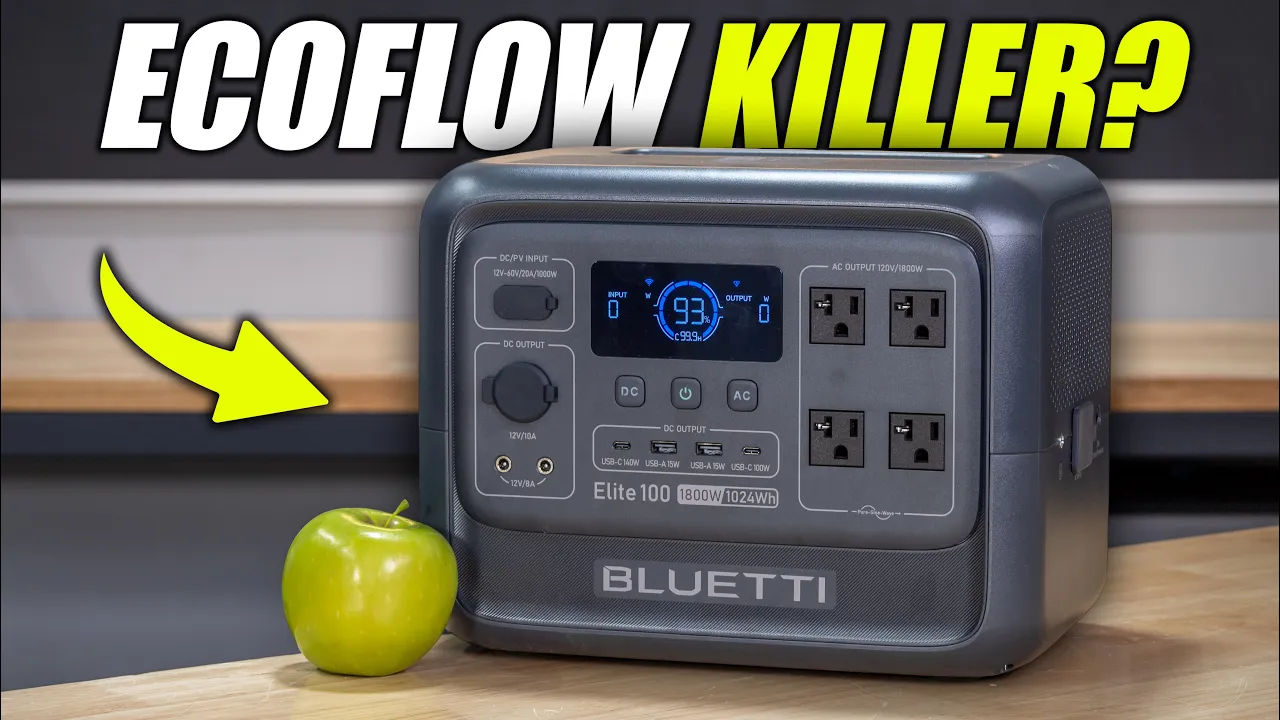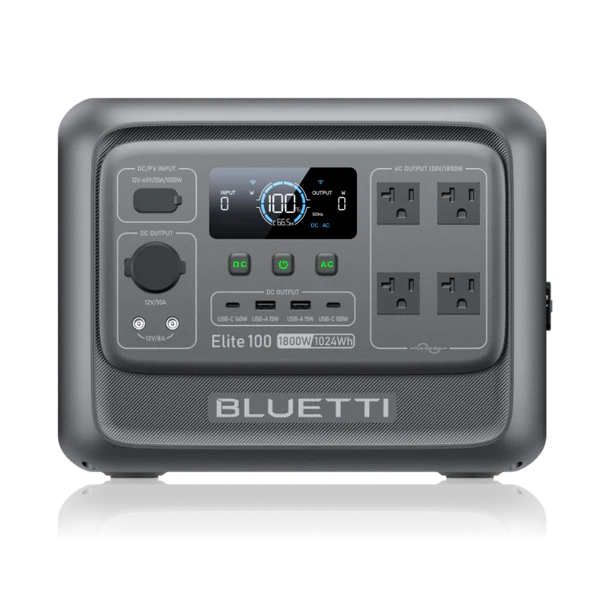

The Bluetti Elite 100 V2 is a brand-new, compact portable power station from an established brand that has been really impressing us lately.
With a 1,024Wh LiFePO₄ battery, a 1,800W inverter, and a surprisingly generous 1,000W solar input, it seems like the Bluetti Elite 100 power station punches well above its weight, especially when you consider the fact it only weighs 25 lbs. Not only is it really portable, it’s also priced like an entry-level unit, but it packs features you’d expect from a high-end power station in this class.
To find out if this thing is actually a really good buy, or if it’s too good to be true, we spent some hands-on time running this unit through some serious testing. Here’s how it performs, what we like about it, and where it falls short.
Before we dive into the nitty-gritty of our review, let’s take a moment to review the specs for this newly released Bluetti power station:
{{review-summary}}
Just like when we reviewed this unit’s big brother, the Bluetti Elite 200 V2, we ran the Bluetti 100 V2 through our standard set of tests and real-world scenarios. Here’s what we found:
Despite its small size and weight, this little Bluetti power station packs a 1,800W pure sine wave inverter. When we pushed it, it was easily able to sustain continuous loads up to its 1,800W rating.
We didn’t notice any overheating issues, and the performance didn’t throttle at all over sustained periods of use. This is pretty impressive for such a compact unit. It also gives us confidence that it would be reliable during a backup power situation.
Bluetti also advertises some really impressive surge capabilities for this little power station. When we first read about it, the 2,700W surge rating seemed like a marketing gimmick. Apparently, the unit is able to spike beyond the continuous output rating thanks to a “2,700 Watt Lift”, which seems to be a temporary voltage tolerance for higher outputs.
It’s similar to EcoFlow’s X-Boost feature, which we have dismissed in the past, but with one important difference: it’s not a permanent state of voltage manipulation. Instead, it alters the voltage and increases the output for short bursts just to start loads that have high start-up power requirements, like power tools and more demanding home appliances.
When we tested it, it seemed to last for only a few seconds to a minute, which was enough to fire up some of the appliances we tested it with. We actually were able to hit a surge spike of 3,200W for a few seconds, which is crazy for such a lightweight and affordable power station.
We measured this unit’s inverter efficiency at right around 80%. This is pretty good for a unit of this class, and we usually give anything around 80% an A grade. It also means a high percentage of your stored power is going to be available to run your loads and charge your devices. Again, this is useful for those looking to purchase a low-cost backup power solution.
We calculated the unit’s idle power draw at right around 16W with the AC inverter on and no load connected. That’s low enough that you can use this power station as a standby unit for a couple of days without having to worry that the battery will be flat when you need it.
For running intermittent loads, like sump pumps and fridges, having a good efficiency rating and low idle draw is really important.
Another thing that really stood out about this Bluetti portable power station is just how high the solar input is in relation to the size of the battery capacity.
This thing only has a battery capacity of 1,024Wh, but it enables solar charging at 1,000W. With that PV input and ideal sun conditions, we were able to hit solar recharge times close to one hour from drained to full.
That makes this one of the faster solar charging power stations in the 1kWh class that we’ve ever tested. It also explains why they seem to market it as a Bluetti solar generator, rather than a Bluetti power station.
As for the AC charging, it’s rated at 1,200W, but we found wall charging this unit a little confusing. It only hit that maximum rated input after the battery passed about 20% battery capacity. Below that, it charged at a rate closer to 500W. Normally, power stations charge really quickly when you first plug them into a wall, then throttle the charge rate as the unit is nearly fully charged. This unit seemed to do the opposite.
Still, we were able to fully charge it in about 1 hour and 39 minutes with a standard wall outlet, which is quick, but not as impressive as the solar charging rate.
Just in terms of the unit’s build and useability, we really like the front-facing ports. When we were using it over the course of a few weeks, we found it really easy to stash in the back of a vehicle. We were still able to access all of the ports, even while it was nearly completely buried in camping gear.
It’s also compatible with the Bluetti alternator charger, which allows you to quickly charge the power station with your vehicle. For off-grid camping and overlanding, this is a really useful feature, so it's an accessory we'd recommend picking up.
The display screen also works quite well, and the smart app allows you to control some basic features remotely, including turning the inverter on and off. This would be really helpful for camping or during a power outage. The app and display screen are also really useful for monitoring, as they allow you to keep an eye on input and output rates.
Now that we’ve discussed our testing, here are a few of the things that surprised and impressed us about the Bluetti 1000 V2 Portable Power Station:
We mentioned it above, but the 1,000W solar input is outstanding for a power station with a 1,024Wh battery. Just using a few solar panels, you can realistically recharge this unit in about 1 hour of good sun. That makes it an excellent solar camping companion or lightweight solar-charged backup power option for blackouts and emergencies.
Even if it couldn’t surge much beyond the 1,800W continuous output that this unit is rated for, the inverter would still be respectable for a power station of this size (and price).
However, those real-world surge capabilities allow it to power everything from hair dryers and microwaves (briefly). It would also work well for powering a 12V fridge and even some power tools. Again, it’s great for basic emergency backup, but also portable enough to be a practical solar generator for camping.
Having an efficiency rating of about 80% and an idle draw of about 16W means less of your battery power is wasted. For a small power station, this is really important.
At right around 25 lbs, it’s very carry-able for weekend camping, van-life, or even just pulling out of storage during a power outage. The front port layout also makes it easy to use when space is tight.
While the built-in handle on the back of the unit could be a little bigger, the unit is compact and lightweight enough that you can bring it pretty much anywhere.
At roughly $425, the Elite 100 V2 competes with budget power stations, like Pecron’s E1000LFP. For perspective, the E1000 is the most similar power station Pecron carries, and it’s priced at around $399.
Given Pecron is usually our benchmark brand for value, and this unit is only about $25 more but carries Bluetti’s brand presence and support, the Bluetti Elite 100 V2 makes a strong case for itself. If you’re looking for a budget-friendly unit, why not pay just a little bit extra for a newer power station from a more reputable brand?
We’ve had issues with Bluetti in the past, but when we were reviewing this unit, we found that all of our attempts to reach Bluetti’s support were really positive. When we called with questions, they were responsive and helpful.
We regularly say that good customer support is one of the most important things you should consider when buying any type of solar equipment. In this case, it’s a meaningful bonus when comparing this unit to some of the unknown low-cost brands out there.
While this unit impressed us, it wasn’t perfect. Here’s a few of the gripes we found when testing and reviewing this small power station:
We say it all the time, but adding a light to a power station that is aimed partly at camping and emergency use is such an easy win. Even a small LED flashlight on the front panel would have been a big win. Sadly, Bluetti seems to refuse to add lights to their power stations. Come on, Bluetti. Just do it already!
While it’s far from the worst we’ve seen, the 120V AC sockets are a bit too close together. If you’re trying to use it with bulky adapters or camera battery chargers, you might find that some of the neighboring plugs will be blocked.
The inverter works so well, so it’s annoying to have multi-device charging impacted by such an easily avoided design issue.
Although the AC input is rated 1,200 Watts, the unit only charges at that rate above a 20% state of charge. Below that threshold, it charges slower (about 500W when we measured it). The full recharge time of about 1 hr 39 min is good, but the early slow phase is curious and adds complexity to planning any sort of short-term gas generator or AC charging.
One of the main units we think this Bluetti power station will compete with is the Pecron E1000LFP, as both have 1,024Wh batteries and 1,800W inverters.
Outside of the slight variation in price, the main difference we noticed was the solar and AC charging. Where the Bluetti solar generator has a huge 1,000W solar input, the Pecron E1000 caps out at 600W. The Pecron power station gives you an extra 120V AC outlet, and we do think it’s a really solid unit for the price, but it’s hard to argue with the Bluetti 100 V2 if it’s only around $25 more expensive.
Even when you compare it to the Bluetti Elite 200 V2, which is basically just a ramped-up version of the Elite 100 V2, that unit is over twice the price of the Elite 100 power station. While those with high output needs are always going to be drawn to a power station with a bigger inverter, the option to pick up two of the Bluetti 100 power stations for less money than one bigger unit is always going to be appealing.
Honestly, you can’t really go wrong with any of these three power stations, but we think those who are looking purely at the price of a solar generator will see a Bluetti power station for under $500 bucks and get pretty excited.
The Bluetti Elite 100 V2 is one of the best value portable power stations we’ve tested at this capacity. For around $425, you get a 1,024Wh LiFePO₄ battery, a robust 1,800W inverter that surges incredibly well, an impressive 1,000W solar input, and just an all-around practical portable power station.
For us, we think it would be an outstanding pick for camping, basic home backup power, and overlanding, especially if you plan to recharge it with solar panels. We weren’t overly impressed when we first started reviewing Bluetti power stations, but hopefully these recent releases represent a trend.
For now, both the Elite 100 V2 and Elite 200 V2 get two thumbs up from us!
